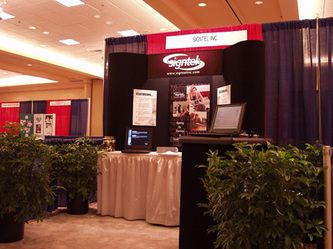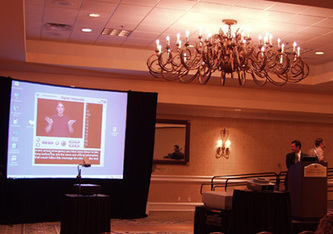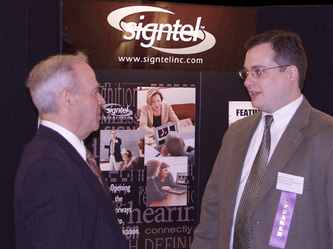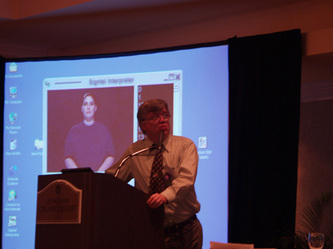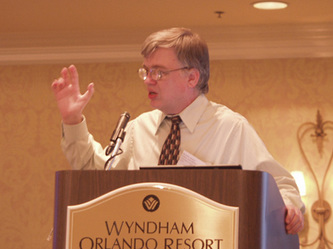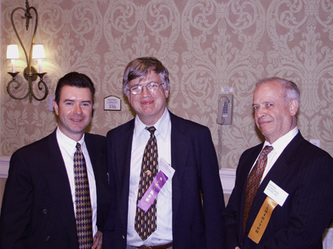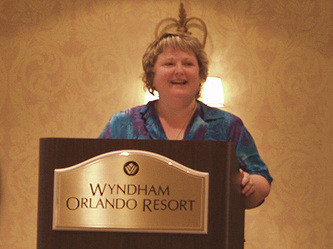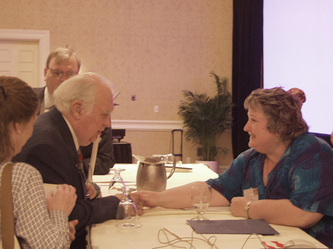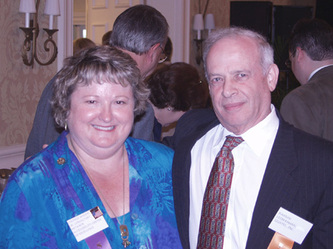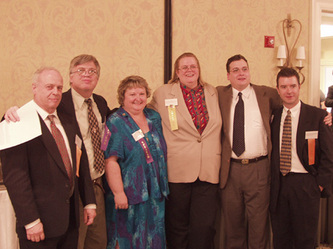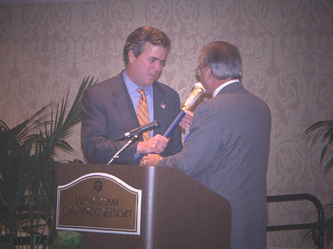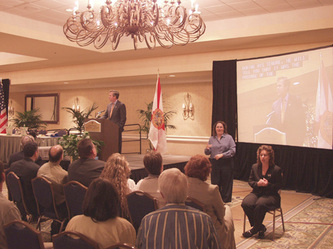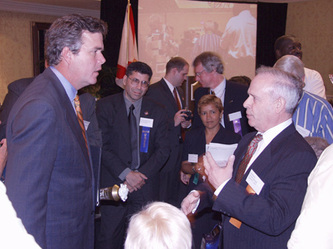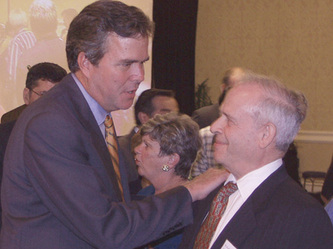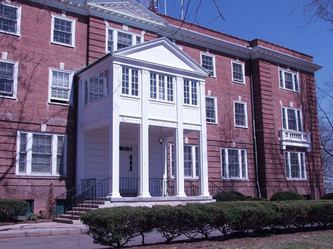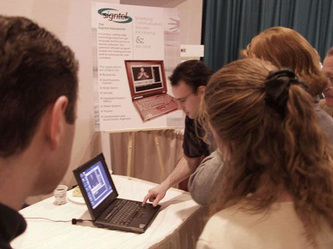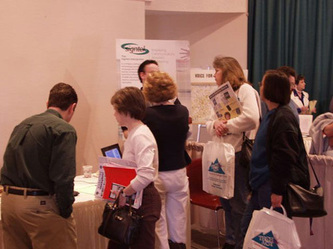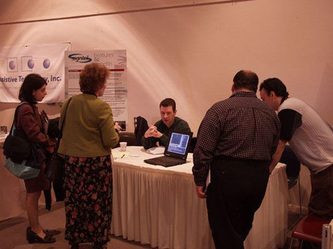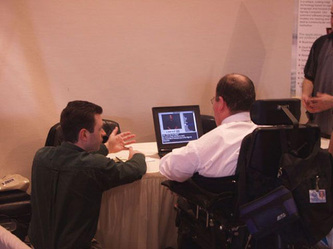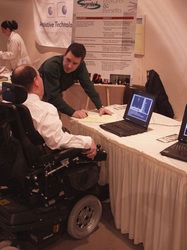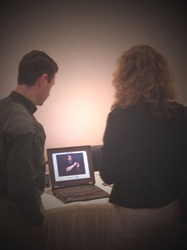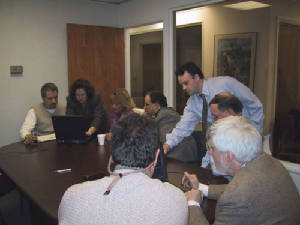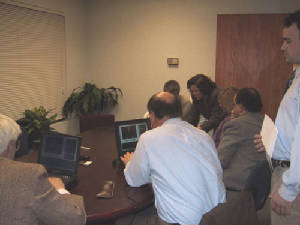Signtel News
ADA CONVENTION - Orlando, FL
Dr. Raanann Liebermann with Governor Bush...Dr. Raanan Liebermann at ADA Convention
Dr. Raanan Liebermann gives special thanks again to Julie Shaw for a job well done. You made our presence at the convention an enjoyable one.
Dr. Raanann Liebermann with Governor Bush...Dr. Raanan Liebermann at ADA Convention
Dr. Raanan Liebermann gives special thanks again to Julie Shaw for a job well done. You made our presence at the convention an enjoyable one.
AAC EXPO - HARTFORD, CT
We were very fortunate to have been an exhibitor at the "2nd Annual AAC Expo" in Hartford, CT. at the NEAT Marketplace...2nd Annual AAC Expo
The NEAT Demonstration Center is, along with the Equipment Restoration Center, one of two major components of the NEAT Marketplace. It is a resource to people with disabilities, their families, and the professionals with whom they work, providing information and hands-on experience with the latest in a wide variety of assistive devices and specialized equipment.
We were very fortunate to have been an exhibitor at the "2nd Annual AAC Expo" in Hartford, CT. at the NEAT Marketplace...2nd Annual AAC Expo
The NEAT Demonstration Center is, along with the Equipment Restoration Center, one of two major components of the NEAT Marketplace. It is a resource to people with disabilities, their families, and the professionals with whom they work, providing information and hands-on experience with the latest in a wide variety of assistive devices and specialized equipment.
Emergency Alert Systems Now Available in Sign Language
North Haven, CT, 2006 Signtel’s new Sign Language Public Address and Emergency Alert System is installed in the Horace Mann School for the Deaf, Boston Public Schools.
Signtel Inc., patent pending Sign Language Public Address and Emergency Alert System is now in Beta and available nationwide. "This product is an important step in furthering accessibility to an important segment of the population" said Ron Liebermann, President and CEO of Signtel Inc. With terrorism and homeland security becoming an increasing subject of concern, it is important to ascertain that deaf individuals can be warned, informed, guided and directed by public addressing systems like their hearing counterparts.
Today public addressing systems are in sound, frequently even the hearing are not able to hear an announcement because of background noise. English text does not provide sufficient accessibility to people who are deaf. The new system allows members of the public who are deaf to be addressed by Sign Language and the hearing by text and voice.
At a designated server or central computer a message is entered into the Sign Language Public Address and Emergency Alert System, either by voice or by typing onto a keyboard. The message can be edited and tested for accuracy and then transmitted to display units such as monitors in designated remote locations from the central computer.
The first Sign Language Public Address and Emergency Alert System was installed by Signtel and The Maricor Group at the Horace Mann School for the Deaf, Boston Public Schools, under the leadership of Principal Jeremiah Ford. The Horace Mann School is the oldest public day school for the Deaf in the United States, educating children and young adults for over 135 years. Signtel Inc., headquartered in North Haven Connecticut develops innovative communication and assistive technologies for people who are deaf or deaf-blind. Signtel can be reached at (203) 248-0600 or through its web site http://www.signtelinc.com
North Haven, CT, 2006 Signtel’s new Sign Language Public Address and Emergency Alert System is installed in the Horace Mann School for the Deaf, Boston Public Schools.
Signtel Inc., patent pending Sign Language Public Address and Emergency Alert System is now in Beta and available nationwide. "This product is an important step in furthering accessibility to an important segment of the population" said Ron Liebermann, President and CEO of Signtel Inc. With terrorism and homeland security becoming an increasing subject of concern, it is important to ascertain that deaf individuals can be warned, informed, guided and directed by public addressing systems like their hearing counterparts.
Today public addressing systems are in sound, frequently even the hearing are not able to hear an announcement because of background noise. English text does not provide sufficient accessibility to people who are deaf. The new system allows members of the public who are deaf to be addressed by Sign Language and the hearing by text and voice.
At a designated server or central computer a message is entered into the Sign Language Public Address and Emergency Alert System, either by voice or by typing onto a keyboard. The message can be edited and tested for accuracy and then transmitted to display units such as monitors in designated remote locations from the central computer.
The first Sign Language Public Address and Emergency Alert System was installed by Signtel and The Maricor Group at the Horace Mann School for the Deaf, Boston Public Schools, under the leadership of Principal Jeremiah Ford. The Horace Mann School is the oldest public day school for the Deaf in the United States, educating children and young adults for over 135 years. Signtel Inc., headquartered in North Haven Connecticut develops innovative communication and assistive technologies for people who are deaf or deaf-blind. Signtel can be reached at (203) 248-0600 or through its web site http://www.signtelinc.com
Deaf and hard of hearing background information Who is deaf ?
According to the National Center for Health Statistics (NCHS) 1990 and 1991 Health Interview Surveys, approximately 20 million people, an astonishing 8.6% of the total U.S. population three years and older were reported to have hearing problems. Of those 20 million, approximately 550,000 are profoundly deaf. The NCHS reports that between one and two of every 1,000 American children have moderate to severe hearing impairment in both ears.
According to the National Center for Health Statistics (NCHS) 1990 and 1991 Health Interview Surveys, approximately 20 million people, an astonishing 8.6% of the total U.S. population three years and older were reported to have hearing problems. Of those 20 million, approximately 550,000 are profoundly deaf. The NCHS reports that between one and two of every 1,000 American children have moderate to severe hearing impairment in both ears.
Raanan Liebermann and President Clinton
University of Oxford North American Alumni Reunion 2002 held at the Waldorf Astoria hotel in New York.
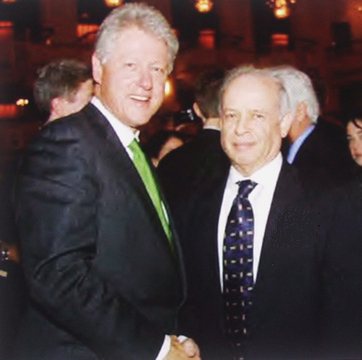
Signtel's first domonstration of the Signtel Interpreter language translation software.
News Related to Intellectual Property of Signtel and members of its team
November 9, 1999 Patent awarded for The Telephone for the Deaf. The technology enables communication between deaf and hearing persons. The deaf person communicates in Sign Language, and the hearing person communicates in voice. The technology translates between the two language forms. The technology also utilizes artificial intelligence, enabling the system to understand meaning of content and facilitate translation of multiple-meaning words.
February 7, 2006 A new patent was awarded to the Signtel team for enabling sight challenged persons to easily locate on demand an enlarged web browser for URL address, as it is positioned at the center of the screen and in an enlarged window, enabling easy typing into it and reading the content.
November 4, 2008 Patent issued for Electronic assistive device for navigation of blind persons. The Electronic Cane device, or eCane communicates with its holder and directs him or her to the desired destination requested by its holder. The communication is either verbal if the eCane holder can speak, or via tactile information, utilizing the Morse code. The eCane also enables face-to-face communication between hearing persons and those who are both blind and deaf and even those who cannot speak. The deaf-blind person inputs what he or she have on their mind by hitting a small button on the eCane in Morse code. The eCane translates it to text; the text to speech and voices it through the speaker on the eCane. When the hearing person speaks, it is picked up by the microphone on the eCane that translates it into text; the text is translated to Morse code and the eCane then delivers the message by vibrating the Morse code.
November 4, 2008 A patent for televisions that cater to persons who are either blind, deaf or both deaf and blind was issued to the Signtel's team. The patent to the technology was awarded in November 2008, ntly with the patent for the eCane. The technology enables a deaf-blind person to enjoy a TV broadcast together with others who can see and hear. The deaf-blind person wears a pair of electronic gloves capable of impinging tactile impacts and selected vibrations. The palm of the user serves as a facsimile of the TV screen on which motions depicting the TV screen activity are felt and the content of activities, verbal communications and sound are converted into tactile form and transmitted through the electronic gloves. A specific language that was developed for such communication, called Touch Language was developed and independently filed as a patent. The Touch Language patent is expected to be issued shortly.
November 24, 2009 The patent of the Telephone for the Deaf was reissued. It also contains the ability for mobile telephone communication where either the hearing, or the deaf person, or both utilize a mobile communication device, where the deaf person can both view in Sign Language the content transmitted, as well as sign to his or her mobile device for the content to be transmitted.
August, 10, 2010 The Signtel team was awarded a patent for enabling deaf persons to see in Sign Language video any emails received, as well as "read" in such Sign Language any content desired appearing on the Internet. This technology opens up the Internet for rapid search and capturing content for those who until now had to rely on figuring out each text word as to its meaning by considering the characters one at atime, because they never heard the words when leaning to read. Besides figuring out the words, they had to further conduct the tiresome task of doing it for the whole sentence.
June 21, 2011 A mobile phone for persons who are blind, deaf, or cannot speak, including those who are both blind, deaf and cannot speak was issued as a patent. It enables full mobile communication with others, including the hearing, right from the eCane. The mobile phone capabilities is an added feature to an earlier patent of the eCane that was awarded in 2008.
January 1, 2013 Signtel team was awarded a patent for an Inclusive Emergency Alert System that enables deaf and / or blind persons to become aware of any alert broadcast in public places, such as malls, bus stations or airports. Deaf persons would be able to see the alert in Sign Language on screens positioned in such places, that would translate any voice alert to text and Sign Language. Persons who are blind, would be able to capture the alerts on their eCanes and receive it through the vibrations on the eCane.
September 3, 2013 The Touch Language patent was issued. Touch Language, which was mentioned in our news about the TV for the deaf and blind was finally issued in September. Touch Language is a language in its own right and tries to avoid the ambiguities of multiple meanings, and grammatical changes as they are related to different articulations based on geographical localities. It is achieved by assigning concepts to fingers of the body and further articulating the concepts through tapping and / or vibrations of the electronic gloves worn for the communication purpose. The plan is to put Touch Language in the public domain and license the electronic gloves for manufacturing and sales to a third party.
MORE NEWS
New Technology Enhances Communication Between The Hearing And The Deaf ECHO PRESS Alexandria, MN May 2, 2001 (Circ.: 11,200) (NAPS) Have you ever tried to communicate with someone from another culture, who speaks an entirely different language than yours? If so, you know it's not an easy undertaking. In fact, there are millions of people born in the United States who don't understand our spoken language of English, but who communicate in their own beautiful and meaningful language. These people were born without the ability to hear, or lost the function when they were very young. America's, deaf and hard of hearing population is estimated at about 20 million, and many of these individuals Communicate using, sign language, a rich and expressive language with its own grammar, rhythm and syntax. Unfortunately for the hearing and for the deaf, most hearing Americans do not understand sign language, and therefore have a hard time communicating with their deaf compatriots. Because of these limitations, the hearing and deaf have had few ways to interact until now. A company based in Connecticut, SignTel, Inc. has developed a communications device that uses new technologies, such as sophisticated linguistic analysis and artificial intelligence, to allow the hearing and deaf to communicate in their own native languages, privately and conveniently. The SignTel Interpreter, a Windows based communications program packaged with a computer such as an IBM ThinkPad computer, provides real time translation of spoken and written English into streaming sign language on screen to facilitate one on one communication between the hearing and the deaf. The developers of this product hope the availability and use of the SignTel Interpreter will encourage hearing people to interact more closely with the deaf and hard of hearing in work and social situations, as they will no longer have to sacrifice confidentiality, convenience, or real time interaction. Current communications systems for the deaf, such as a tele-typewriter (TTY) are cumbersome, time? consuming and lack privacy because they require the participation of a live operator to read text inputted by the deaf person to the hearing party, and type the hearing party's response for the deaf person to read. In addition, such systems lack the sophistication to accurately translate the intended meanings of underlying idioms and turns of phrases into meaningful sign language, The SignTel Interpreter uses sophisticated linguistic analysis and artificial intelligence to translate speech and differentiate between synonyms, multiple meanings and idiomatic phrases. For example, "beat around the bush" cannot be translated directly into sign language, so the SignTel Interpreter translates this phrase into "be direct." According to Maureen Roselli, a sign language teacher and interpreter who is a member of the linguistic team at SignTel, "It is really easy to use and we believe it will facilitate communication between the hearing and deaf in business, social and educational settings within the United States." For more information about the SignTel Interpreter please visit the company's Web site, www.signtelinc.com
New Technologies Offer Help For Those With Disabilities
Written by John Moran for the Hartford Courant, April 12, 2001. John Moran's e-mail address is [email protected] Only when the flu wrecks our week, sending our head and stomach spinning, do we realize just how much we take our health for granted. Yet even the dreaded flu is but a shadow of the challenge facing those whose disabilities are far more profound and lasting. Theirs is a daily battle against the limits of their bodies. Can technology help? You might say people have used technology to compensate for disabilities since the first caveman grabbed a walking stick. Even such innovations as Braille and American Sign Language are arguably technologies, in the sense that they are tools to help those with disabilities communicate. But it is only more recently that computing technology has played a significant role in assisting people with disabilities. Especially in the last five years, computers have begun doing things that were once the stuff of dreams and science fiction. Known generically as "assistive technology", these state-of-the-art products are making life easier and more enjoyable for tens of thousands of citizens with all manner of disabilities. All this became clearer last week when the New England Assistive Technology Marketplace held a showcase of some of the latest innovations at the Connecticut Institute for the Blind/Oak Hill. Dozens of technologies - some aimed at those who are blind or have low-vision, others targeted toward the hearing impaired, still others assisting those who have mobility difficulties - were on display. And even those who are familiar with such technologies found themselves marveling at what can be done with today's equipment. "This is meteoric," said Donald Mason, technology coordinator for Glastonbury Public Schools. "It's incredible how fast this technology has changed." One example is "SignTel Interpreter," a new software program that depicts the image of a woman standing. When you type in a word, phrase or sentence, the computer- generated image instantly translates the information into American Sign Language. At the same time, the information is also spoken aloud by a computer-generated voice. The software, now in final testing, will soon incorporate speech recognition technology. The program would enable a hearing person to communicate with a deaf person simply by speaking to the computer and allowing the computer to display those words as sign language. Other examples included software that would magnify sections of a computer screen so it could be seen more easily by someone with poor vision, software that would read aloud virtually anything typed into it, and software that uses sound to help people with vision problems navigate Windows programs or the internet. "It's vast, the sheer amount of choices that people have," said Rebecca Earl, vice president for the Connecticut Institute for the Blind / Oak Hill. "There are hundreds of thousands of pieces of assistive technology out there." Some of the most intriguing technologies help those with spinal cord injuries that restrict their ability to move their limbs. Special mouse hardware, for example, makes it easier for some to use a PC. And infrared tracking technology lets others move the computer cursor by moving their head. "It was made for people that have spinalcord injury or who have had a stroke," Lee Learson, director of the NEAT Marketplace. "But it's really for anybody who has trouble using the keyboard." Sure, computers are great for helping us compose letters, send and receive e-mail, surf the Web and keep track of our check books. But it's when you see the doors that technology can open for those facing disabilities that you understand just how powerful personal computer can be. Written by John Moran for the Hartford Courant, April 12, 2001. John Moran's e-mail address is [email protected]
Written by John Moran for the Hartford Courant, April 12, 2001. John Moran's e-mail address is [email protected] Only when the flu wrecks our week, sending our head and stomach spinning, do we realize just how much we take our health for granted. Yet even the dreaded flu is but a shadow of the challenge facing those whose disabilities are far more profound and lasting. Theirs is a daily battle against the limits of their bodies. Can technology help? You might say people have used technology to compensate for disabilities since the first caveman grabbed a walking stick. Even such innovations as Braille and American Sign Language are arguably technologies, in the sense that they are tools to help those with disabilities communicate. But it is only more recently that computing technology has played a significant role in assisting people with disabilities. Especially in the last five years, computers have begun doing things that were once the stuff of dreams and science fiction. Known generically as "assistive technology", these state-of-the-art products are making life easier and more enjoyable for tens of thousands of citizens with all manner of disabilities. All this became clearer last week when the New England Assistive Technology Marketplace held a showcase of some of the latest innovations at the Connecticut Institute for the Blind/Oak Hill. Dozens of technologies - some aimed at those who are blind or have low-vision, others targeted toward the hearing impaired, still others assisting those who have mobility difficulties - were on display. And even those who are familiar with such technologies found themselves marveling at what can be done with today's equipment. "This is meteoric," said Donald Mason, technology coordinator for Glastonbury Public Schools. "It's incredible how fast this technology has changed." One example is "SignTel Interpreter," a new software program that depicts the image of a woman standing. When you type in a word, phrase or sentence, the computer- generated image instantly translates the information into American Sign Language. At the same time, the information is also spoken aloud by a computer-generated voice. The software, now in final testing, will soon incorporate speech recognition technology. The program would enable a hearing person to communicate with a deaf person simply by speaking to the computer and allowing the computer to display those words as sign language. Other examples included software that would magnify sections of a computer screen so it could be seen more easily by someone with poor vision, software that would read aloud virtually anything typed into it, and software that uses sound to help people with vision problems navigate Windows programs or the internet. "It's vast, the sheer amount of choices that people have," said Rebecca Earl, vice president for the Connecticut Institute for the Blind / Oak Hill. "There are hundreds of thousands of pieces of assistive technology out there." Some of the most intriguing technologies help those with spinal cord injuries that restrict their ability to move their limbs. Special mouse hardware, for example, makes it easier for some to use a PC. And infrared tracking technology lets others move the computer cursor by moving their head. "It was made for people that have spinalcord injury or who have had a stroke," Lee Learson, director of the NEAT Marketplace. "But it's really for anybody who has trouble using the keyboard." Sure, computers are great for helping us compose letters, send and receive e-mail, surf the Web and keep track of our check books. But it's when you see the doors that technology can open for those facing disabilities that you understand just how powerful personal computer can be. Written by John Moran for the Hartford Courant, April 12, 2001. John Moran's e-mail address is [email protected]
HEALTH & SENIOR NEWS
Assistive Technology Brings New Meaning to Webster's, Disabled Individuals By Thomas Barretta Staff Writer for the West Hartford News April 19,2001 Webster's dictionary defines communication as giving or exchanging of information, signals or messages as by talk, gesture or writing. In order to communicate with others, individuals without a disability do not use assistive technology. But without assistive technology, persons with disabilities would have trouble accessing the internet, reading the newspaper, writing a letter, watching television or communicating to a friend. Every year, new technology is introduced into the marketplace, and with the assistance of the Annual Augmentative and Alternative Communication and Computer Access MiniExpo, presented by the New England Assistive Technology (NEAT) Marketplace, individuals can get hands-on experience with adaptive equipment. On Thursday, April 5, 12 vendors and eight non-profit organizations displayed their products to consumers and professionals at the Second Annual MiniExpo, which took place at the Oak Hill School for the Blind in Hartford. Dr. Rebecca Earl, vice president of the Connecticut Institute of the Blind (CIB) and a West Hartford resident, said in an interview that the purpose of the expo is to introduce new adaptive equipment to consumers, teacher, administrators, and parents of individuals with a disability. The program also gives vendors an opportunity to market their equipment directly to the consumer, she said, and by receiving feedback from professional and customers, the vendor is able to make improvements, enhancements and adjustments to their product. Some of the products that were displayed at the expo were geared toward persons who are blind. Vision Dynamics displayed a Close Circuit Television and Zoomtext. A CCTV enlarges regular print, and magnifies it on a screen. Zoomtext magnifies icons, graphics and text on a computer screen. Individuals who are visually impaired use both of these products. An individual who is blind, or a visually impaired person, will also use a voice-synthesized program called JAWS. This voice-synthesized program helps blind individuals use the Internet, type a thesis, or write an e-mail to a friend. Vision Dynamics sells products for the visually impaired, blind, and learning disabled. Those interested in any of their products can check out their website at http://visiondynamics.com Signtel Inc. is marketing computer software as an extra tool to teach sign language, but not to replace a sign language instructor. It also serves as a method for individuals who are unfamiliar with sign language to make it easier for both parties to communicate with one another. If an employer does not have an employee who knows sign language, the company may be able to use this software as an assistive tool for communicating to an employee who is deaf. When an individual begins typing on an ordinary laptop computer, the Signtel Interpreter software can perform signs and phrases. Greg Mulqueen, sales manager, said that the program is being tested for further development. NEAT not only sponsors mini expos, but also has an Assistive Technology Demonstration Center. The center has state of the art AT equipment, a resource library, adopted computer lab, as well as experts who can demonstrate and teach individuals who are interested in learning assistive technology. One of the vendors present at the MiniExpo was Shirley Fredlund, founder of a program called Voice for Joanie. The program was named after the late Joan Margaitis of Morris, who was a victim of Amyotrophic Lateral Sclerosis, better known as Lou Gehrig's Disease. By hampering her nerves to communicate with her muscles, Ms. Margaitis became totally paralyzed. Because of her disease and paralysis, the only way she could communicate her thoughts and feelings was by blinking her eye. In light of the fact that her friend Joan endured such a crippling disease, Fredlund implemented the Voice for Joanie program. With donations from IBM Inc. and a $1,500 grant, she purchased computer systems that have a voice synthesizer and infrared technology. With the assistance of infrared and the computer, individuals can express their emotions and communicate their opinions to friends and family. The Voice for Joanie program is a non-profit organization that has donated more than 174 adaptive computers to state residents free of charge. The Demonstration Center and MiniExpos also offer equipment that assists persons with other types of disabilities, such as mobility impairment and nervous system impairment. Future demonstrations include the UltimedCo & Wenzelite Expo, a demonstration of pediatric, adult positioning, and mobility devices, which will take place on Thursday, April 26; and the Wheelchair & Mobility Expo, to be presented on Saturday, June 9. Those who are interested in attending or displaying a product at a future expo as a vendor or student, or anyone wishing to learn more about the Demonstration Center, can check out their website at http://neatmarketplace.org or contact Lee Larson, Director of NEAT, at (860) 242-2272.
Assistive Technology Brings New Meaning to Webster's, Disabled Individuals By Thomas Barretta Staff Writer for the West Hartford News April 19,2001 Webster's dictionary defines communication as giving or exchanging of information, signals or messages as by talk, gesture or writing. In order to communicate with others, individuals without a disability do not use assistive technology. But without assistive technology, persons with disabilities would have trouble accessing the internet, reading the newspaper, writing a letter, watching television or communicating to a friend. Every year, new technology is introduced into the marketplace, and with the assistance of the Annual Augmentative and Alternative Communication and Computer Access MiniExpo, presented by the New England Assistive Technology (NEAT) Marketplace, individuals can get hands-on experience with adaptive equipment. On Thursday, April 5, 12 vendors and eight non-profit organizations displayed their products to consumers and professionals at the Second Annual MiniExpo, which took place at the Oak Hill School for the Blind in Hartford. Dr. Rebecca Earl, vice president of the Connecticut Institute of the Blind (CIB) and a West Hartford resident, said in an interview that the purpose of the expo is to introduce new adaptive equipment to consumers, teacher, administrators, and parents of individuals with a disability. The program also gives vendors an opportunity to market their equipment directly to the consumer, she said, and by receiving feedback from professional and customers, the vendor is able to make improvements, enhancements and adjustments to their product. Some of the products that were displayed at the expo were geared toward persons who are blind. Vision Dynamics displayed a Close Circuit Television and Zoomtext. A CCTV enlarges regular print, and magnifies it on a screen. Zoomtext magnifies icons, graphics and text on a computer screen. Individuals who are visually impaired use both of these products. An individual who is blind, or a visually impaired person, will also use a voice-synthesized program called JAWS. This voice-synthesized program helps blind individuals use the Internet, type a thesis, or write an e-mail to a friend. Vision Dynamics sells products for the visually impaired, blind, and learning disabled. Those interested in any of their products can check out their website at http://visiondynamics.com Signtel Inc. is marketing computer software as an extra tool to teach sign language, but not to replace a sign language instructor. It also serves as a method for individuals who are unfamiliar with sign language to make it easier for both parties to communicate with one another. If an employer does not have an employee who knows sign language, the company may be able to use this software as an assistive tool for communicating to an employee who is deaf. When an individual begins typing on an ordinary laptop computer, the Signtel Interpreter software can perform signs and phrases. Greg Mulqueen, sales manager, said that the program is being tested for further development. NEAT not only sponsors mini expos, but also has an Assistive Technology Demonstration Center. The center has state of the art AT equipment, a resource library, adopted computer lab, as well as experts who can demonstrate and teach individuals who are interested in learning assistive technology. One of the vendors present at the MiniExpo was Shirley Fredlund, founder of a program called Voice for Joanie. The program was named after the late Joan Margaitis of Morris, who was a victim of Amyotrophic Lateral Sclerosis, better known as Lou Gehrig's Disease. By hampering her nerves to communicate with her muscles, Ms. Margaitis became totally paralyzed. Because of her disease and paralysis, the only way she could communicate her thoughts and feelings was by blinking her eye. In light of the fact that her friend Joan endured such a crippling disease, Fredlund implemented the Voice for Joanie program. With donations from IBM Inc. and a $1,500 grant, she purchased computer systems that have a voice synthesizer and infrared technology. With the assistance of infrared and the computer, individuals can express their emotions and communicate their opinions to friends and family. The Voice for Joanie program is a non-profit organization that has donated more than 174 adaptive computers to state residents free of charge. The Demonstration Center and MiniExpos also offer equipment that assists persons with other types of disabilities, such as mobility impairment and nervous system impairment. Future demonstrations include the UltimedCo & Wenzelite Expo, a demonstration of pediatric, adult positioning, and mobility devices, which will take place on Thursday, April 26; and the Wheelchair & Mobility Expo, to be presented on Saturday, June 9. Those who are interested in attending or displaying a product at a future expo as a vendor or student, or anyone wishing to learn more about the Demonstration Center, can check out their website at http://neatmarketplace.org or contact Lee Larson, Director of NEAT, at (860) 242-2272.
NEW ASSISTIVE TECHNOLOGY SYSTEM IMPROVES COMMUNICATION BETWEEN THE HEARING AND THE DEAF
Beta Version of the Signtel Interpreter™ is Available Now
North Haven, CT, January 30, 2001 -- SignTel Inc. today announced the availability of the beta version of the Signtel Interpreter™, a new communications system designed to improve interactions between the country’s hearing individuals and the deaf/hard of hearing community, estimated at more than 20 million . The Signtel Interpreter incorporates the language that is considered native to the deaf community, sign language, as an integral part of its program, and provides real time translation of spoken and written English into sign language.
According to Maureen Rosselli, a sign language interpreter and a member of the linguistic team at SignTel Inc., “The culturally Deaf use sign language, a rich and expressive language with its own grammar, rhythm and syntax, to communicate in social, educational and workplace settings. While not meant to replace a live interpreter, this product was developed in the hopes of facilitating interactions between the hearing and the deaf when a live interpreter is not available.”
The Signtel Interpreter is housed on a computer, such as an IBM ThinkPad® notebook, and works by capturing the hearing party's voice through a microphone or via inputted English text, and displaying the translated message in streaming sign language as well as text for the deaf person. The signing figure also enunciates words, making it easy for those who read lips to understand.
Existing telecommunications systems for the deaf, such as the tele-typewriter (TTY), are cumbersome, time-consuming and lack privacy because they require participation of live operators to type the speech content of the hearing so that the deaf can see it in text. The Signtel Interpreter is the first device to accurately translate the intended meanings of sentences, including common idiomatic expressions and turn such phrases into meaningful language for the signing community. It also is able to differentiate between the multiple meanings of words.
According to Ms. Rosselli, phrases such as “beat around the bush” don’t make sense when translated into sign language. The Signtel Interpreter translates this phrase into “avoid.” Other examples include “cool as a cucumber,” which the SignTel Interpreter translates as “calm”; or “once in a blue moon,” translated as “rare.”
“The Signtel Interpreter utilizes advanced technological tools such as sophisticated lexical analysis, artificial intelligence and image processing, in an easy-to-use package to help bridge the communication gap between the hearing and the deaf in the United States,” said Ron Liebermann, Ph.D., president/chief executive officer and chief of technology, SignTel. “In addition, the Signtel Interpreter can boost productivity, enhance morale and foster improved relationships in diverse environments, ranging from small businesses to large companies and educational institutions. It is the first step in a planned series of products that will remove existing barriers of communication.”
The beta version, available now, includes most of the features of Version One, including text-to-sign language translation. It does not include the voice recognition technology that enables voice-to-sign language translationz. Version One, with a unique voice recognition technology that works in tandem with sophisticated lexical analysis, will be available by March of this year. The upgraded feature will be available for free to beta owners.
SignTel Inc., headquartered in North Haven, Connecticut, is engaged in the development of assistive devices and communication technologies for the deaf and hard of hearing. SignTel Inc. currently has more than 120 employees including deaf, hard of hearing, deaf/blind and deaf/low vision. Please feel free to visit the Company’s Web site at signtelinc.com.
Beta Version of the Signtel Interpreter™ is Available Now
North Haven, CT, January 30, 2001 -- SignTel Inc. today announced the availability of the beta version of the Signtel Interpreter™, a new communications system designed to improve interactions between the country’s hearing individuals and the deaf/hard of hearing community, estimated at more than 20 million . The Signtel Interpreter incorporates the language that is considered native to the deaf community, sign language, as an integral part of its program, and provides real time translation of spoken and written English into sign language.
According to Maureen Rosselli, a sign language interpreter and a member of the linguistic team at SignTel Inc., “The culturally Deaf use sign language, a rich and expressive language with its own grammar, rhythm and syntax, to communicate in social, educational and workplace settings. While not meant to replace a live interpreter, this product was developed in the hopes of facilitating interactions between the hearing and the deaf when a live interpreter is not available.”
The Signtel Interpreter is housed on a computer, such as an IBM ThinkPad® notebook, and works by capturing the hearing party's voice through a microphone or via inputted English text, and displaying the translated message in streaming sign language as well as text for the deaf person. The signing figure also enunciates words, making it easy for those who read lips to understand.
Existing telecommunications systems for the deaf, such as the tele-typewriter (TTY), are cumbersome, time-consuming and lack privacy because they require participation of live operators to type the speech content of the hearing so that the deaf can see it in text. The Signtel Interpreter is the first device to accurately translate the intended meanings of sentences, including common idiomatic expressions and turn such phrases into meaningful language for the signing community. It also is able to differentiate between the multiple meanings of words.
According to Ms. Rosselli, phrases such as “beat around the bush” don’t make sense when translated into sign language. The Signtel Interpreter translates this phrase into “avoid.” Other examples include “cool as a cucumber,” which the SignTel Interpreter translates as “calm”; or “once in a blue moon,” translated as “rare.”
“The Signtel Interpreter utilizes advanced technological tools such as sophisticated lexical analysis, artificial intelligence and image processing, in an easy-to-use package to help bridge the communication gap between the hearing and the deaf in the United States,” said Ron Liebermann, Ph.D., president/chief executive officer and chief of technology, SignTel. “In addition, the Signtel Interpreter can boost productivity, enhance morale and foster improved relationships in diverse environments, ranging from small businesses to large companies and educational institutions. It is the first step in a planned series of products that will remove existing barriers of communication.”
The beta version, available now, includes most of the features of Version One, including text-to-sign language translation. It does not include the voice recognition technology that enables voice-to-sign language translationz. Version One, with a unique voice recognition technology that works in tandem with sophisticated lexical analysis, will be available by March of this year. The upgraded feature will be available for free to beta owners.
SignTel Inc., headquartered in North Haven, Connecticut, is engaged in the development of assistive devices and communication technologies for the deaf and hard of hearing. SignTel Inc. currently has more than 120 employees including deaf, hard of hearing, deaf/blind and deaf/low vision. Please feel free to visit the Company’s Web site at signtelinc.com.
MARKETING HELPFUL MACHINES
Exposition Offers Education And Assistance Devices By Carmel M. Owens Hartford Courant Staff Writer April 10, 2000 Kathy-Anne Winnie lost part of her arm as the result of a car accident 13 years ago. Back then, she said, it wasn't easy to find products to help with her disability. But times have changed. Winnie attended the second exposition of the New England Assistive Technology Marketplace held last Wednesday at The Connecticut Institute for the Blind/Oak Hill School. The NEAT Marketplace is a program of CIB/Oak Hill designed to educate the public about devices available to people with disabilities. The group also works to restore durable medical equipment. "I just really think this is a good program," Winnie, of Springfield, said. "You need help, you want help, you just don't know where to go sometimes." NEAT Marketplace opened in September and is housed temporarily in a building on the Oak Hill campus off Holcomb Street. Plans for a new on-campus building are in the works for September 2001. During the exposition, a new computer lab was officially opened. The lab features special keyboards, computer mice and software programs for people with disabilities. The lab will be open five days a week for those who are considering the purchase of new equipment but want to learn if it's right for them. "The idea here is that people understand that we're here when need questions answered about technology," said Rebecca Earl, vice president of CIB. "This is the standard in the new millennium." NEAT accepts donations of all durable medical equipment and restores them for other companies who sell them to the public at a reduced price. They also take equipment on a consignment basis, as long as the product is worth at least $750. Kim Raub attended the exposition with her 2-year-old son, Teddy, who has polymicrogyria, a disease that prevents him from speaking. Raub, of Wallingford, attended with her son's speech therapist, checking out the latest in voice technology. Although shi is teaching Teddy sign language, Raub said she needs to seek out alternative forms of communication too, since most people don't use sign language. "There's nothing worse than buying something blindly, spending $300 for something that doesn't work for you," Raub said. "We have to make sure he communicates so he doesn't get frustrated. When he gets frustrated, he gets angry." Aside from the computer lab and equipment repair, NEAT Marketplace director Lee Learson said training and workshops are being planned. On April 26 there will be a workshop on environmental modifications: a June 1 workshop will explore sports, toys and recreation. On May17 Neat will sponsor the New England Wheelchair Sports League Seminar, at which specialized wheelchairs for racing, tennis, soccer and more will be available. For more information on NEAT Marketplace, please call Lee Learson at 242-2274, Ext. 3378.
Exposition Offers Education And Assistance Devices By Carmel M. Owens Hartford Courant Staff Writer April 10, 2000 Kathy-Anne Winnie lost part of her arm as the result of a car accident 13 years ago. Back then, she said, it wasn't easy to find products to help with her disability. But times have changed. Winnie attended the second exposition of the New England Assistive Technology Marketplace held last Wednesday at The Connecticut Institute for the Blind/Oak Hill School. The NEAT Marketplace is a program of CIB/Oak Hill designed to educate the public about devices available to people with disabilities. The group also works to restore durable medical equipment. "I just really think this is a good program," Winnie, of Springfield, said. "You need help, you want help, you just don't know where to go sometimes." NEAT Marketplace opened in September and is housed temporarily in a building on the Oak Hill campus off Holcomb Street. Plans for a new on-campus building are in the works for September 2001. During the exposition, a new computer lab was officially opened. The lab features special keyboards, computer mice and software programs for people with disabilities. The lab will be open five days a week for those who are considering the purchase of new equipment but want to learn if it's right for them. "The idea here is that people understand that we're here when need questions answered about technology," said Rebecca Earl, vice president of CIB. "This is the standard in the new millennium." NEAT accepts donations of all durable medical equipment and restores them for other companies who sell them to the public at a reduced price. They also take equipment on a consignment basis, as long as the product is worth at least $750. Kim Raub attended the exposition with her 2-year-old son, Teddy, who has polymicrogyria, a disease that prevents him from speaking. Raub, of Wallingford, attended with her son's speech therapist, checking out the latest in voice technology. Although shi is teaching Teddy sign language, Raub said she needs to seek out alternative forms of communication too, since most people don't use sign language. "There's nothing worse than buying something blindly, spending $300 for something that doesn't work for you," Raub said. "We have to make sure he communicates so he doesn't get frustrated. When he gets frustrated, he gets angry." Aside from the computer lab and equipment repair, NEAT Marketplace director Lee Learson said training and workshops are being planned. On April 26 there will be a workshop on environmental modifications: a June 1 workshop will explore sports, toys and recreation. On May17 Neat will sponsor the New England Wheelchair Sports League Seminar, at which specialized wheelchairs for racing, tennis, soccer and more will be available. For more information on NEAT Marketplace, please call Lee Learson at 242-2274, Ext. 3378.
PRESS RELEASES
aanaNote: The free Signtel Interpreter offer was discontinued at the end of 2006 Free Software Allows Deaf to Communicate with Hearing
North Haven, CT., July 10, 2003, Signtel, Inc. announced today that the Signtel Interpreter software, which was developed with over 100 deaf and hard of hearing employees, is now free to individuals for residential use and schools, under the "Free Signtel Interpreter Program". To obtain the software, individuals can either copy it from friends or order a disk on-line, from Signtel's web site (www.signtelinc.com). Disks containing the free Signtel Interpreter software ship for $6.95 per disk, which includes shipping and handling. Direct downloads from the Internet are not available at this time. The size of the Signtel Interpreter software would limit such direct download only to users with fast processors and Broadband or DSL. The Program presents an unusual opportunity for individuals using sign language or wanting to learn it. The Signtel Interpreter is a unique, cutting edge technology that translates text into sign language viewed on a computer screen in real-time. The product embraces artificial intelligence, complex lexical analysis, recognizing over 30,000 words and over 1,400 idioms and phrases.
Some additional features are:
* Seamless connectivity between signs
* Text to speech conversion
* Conceptually accurate translation to sign language
* Correct signing for money, time, decimals, phone numbers, double letters, names such as Mr. Brown, correct signing of multiple meaning words
* Built in spell checker
* Signing pop up window quickly translates emails and text documents
* Optional auxiliary feature ignores words such as "are", "the", "to"
* Drag and Drop feature to save text or bring it back for signing
* Signer's mouth visible clearly enunciating words, and much more.
The Free Signtel Interpreter Program does not include the "Signtel Interpreter VR. While it does not have speech recognition, it is the same in every other way to the Signtel Interpreter VR.
"We want to enable individuals and schools to access such developed technology, " said Raanan Liebermann, President and CEO of Signel Inc.
Signtel Inc., headquartered in North Haven Connecticut, develops communication and security technologies for deaf and blind individuals. In recent years Signtel has developed over 20 patented or patent pending new technologies. Signtel is the developer and manufacturer of the Signtel Interpreter VR, with the state of the art speech recognition, which has received high acclaims for its speech recognition accuracy.
Note: The free Signtel Interpreter offer was discontinued at the end of 2006
North Haven, CT., July 10, 2003, Signtel, Inc. announced today that the Signtel Interpreter software, which was developed with over 100 deaf and hard of hearing employees, is now free to individuals for residential use and schools, under the "Free Signtel Interpreter Program". To obtain the software, individuals can either copy it from friends or order a disk on-line, from Signtel's web site (www.signtelinc.com). Disks containing the free Signtel Interpreter software ship for $6.95 per disk, which includes shipping and handling. Direct downloads from the Internet are not available at this time. The size of the Signtel Interpreter software would limit such direct download only to users with fast processors and Broadband or DSL. The Program presents an unusual opportunity for individuals using sign language or wanting to learn it. The Signtel Interpreter is a unique, cutting edge technology that translates text into sign language viewed on a computer screen in real-time. The product embraces artificial intelligence, complex lexical analysis, recognizing over 30,000 words and over 1,400 idioms and phrases.
Some additional features are:
* Seamless connectivity between signs
* Text to speech conversion
* Conceptually accurate translation to sign language
* Correct signing for money, time, decimals, phone numbers, double letters, names such as Mr. Brown, correct signing of multiple meaning words
* Built in spell checker
* Signing pop up window quickly translates emails and text documents
* Optional auxiliary feature ignores words such as "are", "the", "to"
* Drag and Drop feature to save text or bring it back for signing
* Signer's mouth visible clearly enunciating words, and much more.
The Free Signtel Interpreter Program does not include the "Signtel Interpreter VR. While it does not have speech recognition, it is the same in every other way to the Signtel Interpreter VR.
"We want to enable individuals and schools to access such developed technology, " said Raanan Liebermann, President and CEO of Signel Inc.
Signtel Inc., headquartered in North Haven Connecticut, develops communication and security technologies for deaf and blind individuals. In recent years Signtel has developed over 20 patented or patent pending new technologies. Signtel is the developer and manufacturer of the Signtel Interpreter VR, with the state of the art speech recognition, which has received high acclaims for its speech recognition accuracy.
Note: The free Signtel Interpreter offer was discontinued at the end of 2006
Sign Language Video Clips "on demand" for web sites:
A new, unique and revolutionary service announced by SignTel., Inc.
North Haven, CT, November 13, 2001 - SignTel, Inc. announced today a new service, bridging global communications between the hearing and the deaf. The Sign language Video Clips service by SignTel enables any business or individual to purchase, for a nominal fee, video clips that sign desired sentences to visitors to web sites, or enable usage with material presentations such as Microsoft's Power Point.
Webmasters, or web designers, can now include on their site any chosen sentences to appear in sign language on their web site, by submitting such selected text to SignTel's Signing Video Clips engine. The respective generated signs are sent back as e-mail with attached video clips ready for use. When used in presentations, users who acquire SignTel Video Clips can easily integrate them into any presentation material.
SignTel Video Clips are fully "508 compatible", that is, they can be used by all groups, whether they are deaf, blind, deaf-blind or deaf low vision. The Clips include descriptive text portions that make them accessible for screen readers.
"Our aim is to provide to as many web sites as possible, the capability of being Deaf friendly" said Raanan Liebermann, President and CEO of SignTel. "To enhance wide use of the service, SignTel also enables its Video Clips to be used with such products as Microsoft Power Point and in addition offers commercial incentives" added Dr. Raanan Liebermann.
The incentives allow for an automatic referral fee paid by SignTel to any web site that previously purchased such service and from which a new order comes through a link to its web site (signtelinc.com). Under the incentive plan, any request for Signing Video Clips will automatically credit such linking web site with 15% of the collected amounts. Furthermore, any purchase of one or more Signtel Interpreter(s) orders received through such linking web sites will credit these sites with 3% of the collected amounts.
SignTel, Inc. introduced the Signtel Interpreter earlier in August this year and also announced this month a consumer version of that product at a greatly reduced price of $499.95. The Signtel Interpreter translates speech and text to seamless sign language and is conceptually accurate, and recognizes over 30,000 words, including over 1000 idioms. The commercial version of the Signtel Interpreter is sold either as a software only product or mounted on a laptop.
SignTel, Inc. develops communication technologies for the deaf and hard of hearing. The Company has hired over 100 deaf and hard of hearing employees in the last three years and relies heavily on their participation in the development and need assessments of the company's products.
For more information visit the company's web site at www.signtelinc.com
A new, unique and revolutionary service announced by SignTel., Inc.
North Haven, CT, November 13, 2001 - SignTel, Inc. announced today a new service, bridging global communications between the hearing and the deaf. The Sign language Video Clips service by SignTel enables any business or individual to purchase, for a nominal fee, video clips that sign desired sentences to visitors to web sites, or enable usage with material presentations such as Microsoft's Power Point.
Webmasters, or web designers, can now include on their site any chosen sentences to appear in sign language on their web site, by submitting such selected text to SignTel's Signing Video Clips engine. The respective generated signs are sent back as e-mail with attached video clips ready for use. When used in presentations, users who acquire SignTel Video Clips can easily integrate them into any presentation material.
SignTel Video Clips are fully "508 compatible", that is, they can be used by all groups, whether they are deaf, blind, deaf-blind or deaf low vision. The Clips include descriptive text portions that make them accessible for screen readers.
"Our aim is to provide to as many web sites as possible, the capability of being Deaf friendly" said Raanan Liebermann, President and CEO of SignTel. "To enhance wide use of the service, SignTel also enables its Video Clips to be used with such products as Microsoft Power Point and in addition offers commercial incentives" added Dr. Raanan Liebermann.
The incentives allow for an automatic referral fee paid by SignTel to any web site that previously purchased such service and from which a new order comes through a link to its web site (signtelinc.com). Under the incentive plan, any request for Signing Video Clips will automatically credit such linking web site with 15% of the collected amounts. Furthermore, any purchase of one or more Signtel Interpreter(s) orders received through such linking web sites will credit these sites with 3% of the collected amounts.
SignTel, Inc. introduced the Signtel Interpreter earlier in August this year and also announced this month a consumer version of that product at a greatly reduced price of $499.95. The Signtel Interpreter translates speech and text to seamless sign language and is conceptually accurate, and recognizes over 30,000 words, including over 1000 idioms. The commercial version of the Signtel Interpreter is sold either as a software only product or mounted on a laptop.
SignTel, Inc. develops communication technologies for the deaf and hard of hearing. The Company has hired over 100 deaf and hard of hearing employees in the last three years and relies heavily on their participation in the development and need assessments of the company's products.
For more information visit the company's web site at www.signtelinc.com
Sign Language Technology becomes a consumer product: SignTel, Inc. announces revolutionary pricing for state of the art technology that enables deaf and hard of hearing individuals to afford a signing engine for word processing, the Internet, reading emails, or as a personal aid in learning sign language.
North Haven, CT, November 1, 2001 - SignTel, Inc. announced today a text only version of its unique Signtel Interpreter software for individual, non-business, consumer users. The software product is geared for home or classroom use by individuals. The Signtel Interpreter consumer version software is aggressively priced at $499.95. It includes the unique seamless signing that is one of the hallmarks of the Company, as well as its ability to recognize and sign over 30,000 words, as well as phrases and idioms. The product enables users to port Internet material and email, reading it all in sign language. One can also activate the SignTel Interpreter via hotkey from within Microsoft Word.
" Our deaf and hard of hearing employees have indicated that a text version is very desirable for many deaf and hard of hearing individuals" said Ron Liebermann, President and CEO of SignTel. "These employees are dedicated and are an integral part of our development and market building" he continued.
The price of such technology has been a problem for many potential individual users who have been unable to afford the benefits of such new developments. SignTel, encouraged by its deaf and hard of hearing employees, decided to take a responsive and bold move to pioneer reduced consumer prices for its revolutionary technology. In the last three years SignTel has hired well over 100 deaf and hard of hearing employees and is proud to have among their ranks several that are deaf blind and deaf low vision.
While the product is not ASL, SignTel's deaf and hard of hearing employees state that though it may not be suitable for everyone, it enables signing without auxiliaries when desired and point out that many late deaf signers will be thrilled with the ability to now acquire such a unit. The unit is also an excellent tool, they point out for learning sign language. Users can control the speed of the signer from very fast to very slow, which is extremely valuable when learning how to sign. While this version is without speech recognition that is part of the Signtel Interpreter VR business version, upgrades to speech recognition version will become available. It should be noted however, that the unit does use voice in expressing the signed material. The software can be downloaded onto almost any windows based computer sold today.
SignTel, Inc. develops communication technologies for the deaf and hard of hearing and is a major employer of such individuals in 25 states. The Company is now accepting orders either on its web site or by mail and anticipates product shipment this month.
For more information visit the company's web site at www.signtelinc.com
North Haven, CT, November 1, 2001 - SignTel, Inc. announced today a text only version of its unique Signtel Interpreter software for individual, non-business, consumer users. The software product is geared for home or classroom use by individuals. The Signtel Interpreter consumer version software is aggressively priced at $499.95. It includes the unique seamless signing that is one of the hallmarks of the Company, as well as its ability to recognize and sign over 30,000 words, as well as phrases and idioms. The product enables users to port Internet material and email, reading it all in sign language. One can also activate the SignTel Interpreter via hotkey from within Microsoft Word.
" Our deaf and hard of hearing employees have indicated that a text version is very desirable for many deaf and hard of hearing individuals" said Ron Liebermann, President and CEO of SignTel. "These employees are dedicated and are an integral part of our development and market building" he continued.
The price of such technology has been a problem for many potential individual users who have been unable to afford the benefits of such new developments. SignTel, encouraged by its deaf and hard of hearing employees, decided to take a responsive and bold move to pioneer reduced consumer prices for its revolutionary technology. In the last three years SignTel has hired well over 100 deaf and hard of hearing employees and is proud to have among their ranks several that are deaf blind and deaf low vision.
While the product is not ASL, SignTel's deaf and hard of hearing employees state that though it may not be suitable for everyone, it enables signing without auxiliaries when desired and point out that many late deaf signers will be thrilled with the ability to now acquire such a unit. The unit is also an excellent tool, they point out for learning sign language. Users can control the speed of the signer from very fast to very slow, which is extremely valuable when learning how to sign. While this version is without speech recognition that is part of the Signtel Interpreter VR business version, upgrades to speech recognition version will become available. It should be noted however, that the unit does use voice in expressing the signed material. The software can be downloaded onto almost any windows based computer sold today.
SignTel, Inc. develops communication technologies for the deaf and hard of hearing and is a major employer of such individuals in 25 states. The Company is now accepting orders either on its web site or by mail and anticipates product shipment this month.
For more information visit the company's web site at www.signtelinc.com
aananThe Future of Telecom: Enabling the deaf and hearing to communicate with each other.
North Haven, CT, August 15, 2001 - SignTel, Inc. introduced today the Signtel Interpreter: the most advanced communications tool that enables direct communication between hearing and deaf persons. For the first time, a unique, cutting edge technology enables viewing on the screen, seamless signing in real-time, translated from text or captured voice.
Artificial intelligence, complex lexical analysis and over 30,000 recognizable words and phrases make the Signtel Interpreter a powerful translation tool from text or speech to sign language. It can be housed on most laptops or desktop computers.
This new patented technology will revolutionize communication with the 20 million deaf and hard of hearing persons in the United States in schools, hospitals, police stations, libraries, hotels, retail and businesses.
SignTel has received solid reviews from the successfully completed six months of Beta testing that preceded today's release.
"Products such as SignTel's are creating opportunities for people with hearing disabilities that were unthinkable just a few years ago", says Mark Urban, of the International Center for Disability Resources on the Internet who is also the Vice Chair, National Committee on Information Technology Standards. Furthermore, according to Mark Urban, "This type of technology
will provide a cost-effective method for making presentations and multimedia training accessible, whether it is in the classroom or the boardroom".
"We are gratified by the beta testers positive embrace of the Signtel Interpreter, and are excited by their response. We envision this technology to become the standard in communication between the hearing and deaf and an integral part of every educational and service organization in the
country. By integrating it into existing products and technological advances, companies both comply with the government regulations, and can also make a difference to individuals who need communication assistance", said Raanan Liebermann, President and CEO of SignTel.
SignTel, Inc., headquartered in North Haven, Connecticut, develops communication technologies for the deaf and hard of hearing. SignTel is a major employer of deaf and hard of hearing individuals and currently employs about 70 such individuals, several of whom are deaf-blind or deaf low vision, spanning 25 states.
The Signtel Interpreter is demonstrated and featured in lectures today and tomorrow at the ADA Working Group convention in Orlando, Florida. For more information, visit the Company's Web site at www.signtelinc.com
North Haven, CT, August 15, 2001 - SignTel, Inc. introduced today the Signtel Interpreter: the most advanced communications tool that enables direct communication between hearing and deaf persons. For the first time, a unique, cutting edge technology enables viewing on the screen, seamless signing in real-time, translated from text or captured voice.
Artificial intelligence, complex lexical analysis and over 30,000 recognizable words and phrases make the Signtel Interpreter a powerful translation tool from text or speech to sign language. It can be housed on most laptops or desktop computers.
This new patented technology will revolutionize communication with the 20 million deaf and hard of hearing persons in the United States in schools, hospitals, police stations, libraries, hotels, retail and businesses.
SignTel has received solid reviews from the successfully completed six months of Beta testing that preceded today's release.
"Products such as SignTel's are creating opportunities for people with hearing disabilities that were unthinkable just a few years ago", says Mark Urban, of the International Center for Disability Resources on the Internet who is also the Vice Chair, National Committee on Information Technology Standards. Furthermore, according to Mark Urban, "This type of technology
will provide a cost-effective method for making presentations and multimedia training accessible, whether it is in the classroom or the boardroom".
"We are gratified by the beta testers positive embrace of the Signtel Interpreter, and are excited by their response. We envision this technology to become the standard in communication between the hearing and deaf and an integral part of every educational and service organization in the
country. By integrating it into existing products and technological advances, companies both comply with the government regulations, and can also make a difference to individuals who need communication assistance", said Raanan Liebermann, President and CEO of SignTel.
SignTel, Inc., headquartered in North Haven, Connecticut, develops communication technologies for the deaf and hard of hearing. SignTel is a major employer of deaf and hard of hearing individuals and currently employs about 70 such individuals, several of whom are deaf-blind or deaf low vision, spanning 25 states.
The Signtel Interpreter is demonstrated and featured in lectures today and tomorrow at the ADA Working Group convention in Orlando, Florida. For more information, visit the Company's Web site at www.signtelinc.com
